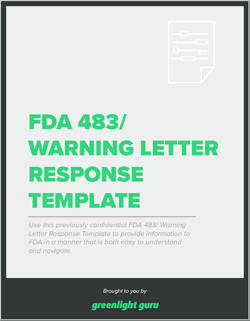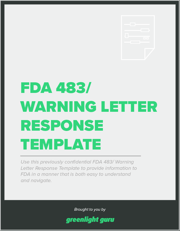7 Steps to Respond to FDA 483 Inspection Observations (Response Template Included)

Attention: If you are a medical device company and you have class II or class III products registered with FDA, you will be inspected by FDA.
Whether you have been through FDA inspections before or not, I highly recommend you spend some time preparing for their impending visit.
There are some surefire ways to fail your FDA inspection and receive dozens of FDA 483 inspection observations. And despite your best efforts, it is very likely that you will receive some 483s.
Your behavior during the FDA inspection is important, of course. But your behavior post-inspection, corresponding with FDA, and closing out 483s is even more important; otherwise, you may face more serious recourse like FDA warning letters.
As the FDA inspector wraps up the inspection, he will share with you a summary of his observations. In the event that the inspector found issues, he will discuss and provide a draft of FDA Form 483 Inspectional Observations. The inspector will ask if you agree to correct the issues and record your responses.
And please, please make sure you understand the FDA inspector’s observations and comments. Ask questions before the inspector finalizes the draft 483 and leaves your facility. Having a clear understanding of the issues is very important for you to be able to address and satisfy FDA’s concerns.
What you do next is the most important step in working towards a resolution of the 483s. Realize that the clock is ticking and you have 15 days to provide an initial response to FDA regarding the 483 observations.
Do not wait until you receive the official FDA Establishment Inspection Report! This may not arrive for 30 days or longer after the inspection.
How to respond to FDA Form 483 inspection observations
Step 1: Establish a timeline for response activities
Once the FDA inspection is completed and you have been provided a list of 483 observations, the clock starts ticking. You now have 15 days to provide a response to FDA.
I highly suggest that your first step in dealing with mitigating FDA issues is to set a firm and aggressive timeline for preparing your response. Even if you only have a few 483s, those 15 days will fly by very quickly.
You want that initial response to be thorough and represent your commitment to correcting all the issues identified by the inspector. The steps outlined below should serve as a guide for major steps to include in this response timeline. Realize that your 483 response is a project. Treat it that way.
Step 2: Identify root cause
With 483 observations in hand, you need to determine the root causes of the issue. It is possible that a root cause analysis may be part of your overall CAPA procedure. There are many tools and techniques, such as fishbone diagrams and 5 whys, for analyzing root causes.

The tool selection is less important as long as you drive to the actual root cause. A very common mistake with determining root causes is that this is often a restatement of the problem or issue.
Step 3: Issuing CAPAs
Once you have identified root causes for each 483 observation, you should draft and issue for corrective action plans, or CAPAs. I recommend that you issue a separate CAPA for each individual 483.
Your CAPAs should specify:
-
Description of the issue. Copy and paste the exact wording of the FDA 483 observation
-
Root cause analysis
-
Immediate corrections required
-
Corrective action plan to prevent occurrence / recurrence
-
Assignment of CAPA owner
Step 4: Establish a timeline for addressing 483s
FDA will expect you to address and mitigate the issues with a sense of urgency. As you develop the CAPAs and the specific action plans, you should also establish a timeline. CAPAs are projects and good project management practices should be employed.
You may want to be super-aggressive and make a commitment to address the 483s as quickly as possible. Don’t fall into this trap! Your knee-jerk reaction will be to try to close as many of the issues prior to submitting your initial response.
FDA expects you to follow your CAPA process and to take the appropriate amount of time to correct the issues and to prevent these issues from recurring. Yes, these CAPAs are likely to rise to the top of your company priorities. Just be realistic.
Step 5: Draft initial response letter
Now that you know what will be required (at least from a high level), it’s time to draft your initial 483 response letter to send to FDA.
I recommend including an appendix (as noted in the letter above) that summarizes each individual 483 observation and the corrective actions required to address. You can include copies of your CAPAs.
Step 6: Consistent follow up
In your initial response letter, you should specify when the next update will be provided to FDA and how often you will send updates. To some extent, this will depend on the magnitude of the corrections required. As a rule of thumb, I recommend sending updates about every 4‑6 weeks.
With each subsequent update letter, you should be very repetitive. The main body of the letter will likely be very similar to the initial response. You should always include the appendix, stating the same information provided in the initial response, while including updates for when items are completed.
It is possible that FDA will provide a response to each correspondence.
When you feel you have successfully addressed the 483 observations, then your next correspondence to FDA should state this. FDA will likely respond and may have follow-up questions or accept your statement.
Step 7: Get ready for re-inspection
Yep, that’s right. Once you have successfully completed corrections for the 483 observations, there is a very good chance you will have a follow-up visit from a FDA inspector. And this next visit will likely be unannounced.
The intent of this follow-up is to verify that your company has addressed and documented actions taken appropriately and to observe that corrective actions are effectively implemented. Generally, this follow-up inspection is just a couple days—unless the FDA inspector is not satisfied.
This article originally appeared as a guest expert post on Medtech Intelligence and is being republished here with permission.
Looking for an all-in-one QMS solution to advance the success of your in-market devices and integrates your quality processes with product development efforts? Click here to take a quick tour of Greenlight Guru's Medical Device QMS software →
Jon Speer is a medical device expert with over 20 years of industry experience. Jon knows the best medical device companies in the world use quality as an accelerator. That's why he created Greenlight Guru to help companies move beyond compliance to True Quality.
Related Posts
An FDA Inspection Will Happen
How To Prepare for an FDA Inspection (Plus 5 Tips)
Here Are the 4 Types of FDA Inspections You Need to Understand
Get your free resource
FDA 483/ Warning Letter Response Template












